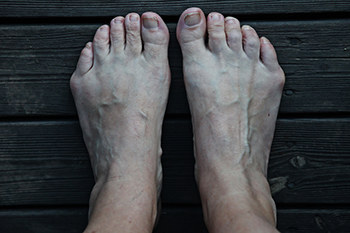 You may have heard of bunions, which sometimes pop up at the base of the big toe joint, but what is a bunionette? Bunionettes, also known as tailor’s bunions, are small, bony bumps that occur at the base of the pinky toe joints. Much like regular bunions, bunionettes can be painful, swollen, and red. Finding comfortable shoes that don’t rub up against the affected area may be difficult. Without treatment, bunionettes usually worsen over time. Fortunately, conservative treatments such as wearing wider shoes, a toe spacer, padding, and activity modifications, are often effective in managing the condition. Surgery to correct a bunionette may be beneficial for a smaller percentage of people. To learn more about bunionettes and what treatment methods are best for you, please consult with a podiatrist.
You may have heard of bunions, which sometimes pop up at the base of the big toe joint, but what is a bunionette? Bunionettes, also known as tailor’s bunions, are small, bony bumps that occur at the base of the pinky toe joints. Much like regular bunions, bunionettes can be painful, swollen, and red. Finding comfortable shoes that don’t rub up against the affected area may be difficult. Without treatment, bunionettes usually worsen over time. Fortunately, conservative treatments such as wearing wider shoes, a toe spacer, padding, and activity modifications, are often effective in managing the condition. Surgery to correct a bunionette may be beneficial for a smaller percentage of people. To learn more about bunionettes and what treatment methods are best for you, please consult with a podiatrist.
If you are suffering from bunions, contact Dr. Richard DiMario of Maine. Our doctor can provide the care you need to keep you pain-free and on your feet.
What Is a Bunion?
A bunion is formed of swollen tissue or an enlargement of boney growth, usually located at the base joint of the toe that connects to the foot. The swelling occurs due to the bones in the big toe shifting inward, which impacts the other toes of the foot. This causes the area around the base of the big toe to become inflamed and painful.
Why Do Bunions Form?
Genetics – Susceptibility to bunions are often hereditary
Stress on the feet – Poorly fitted and uncomfortable footwear that places stress on feet, such as heels, can worsen existing bunions
How Are Bunions Diagnosed?
Doctors often perform two tests – blood tests and x-rays – when trying to diagnose bunions, especially in the early stages of development. Blood tests help determine if the foot pain is being caused by something else, such as arthritis, while x-rays provide a clear picture of your bone structure to your doctor.
How Are Bunions Treated?
If you have any questions, please feel free to contact our office located in York, ME . We offer the newest diagnostic and treatment technologies for all your foot care needs.
 The plantar fascia is a strong and thick tissue that runs along the bottom of the foot and connects the heel bone to the toes. Plantar fasciitis occurs when this piece of tissue becomes inflamed or torn. Generally, plantar fasciitis is caused by overstretching or overuse and causes heel pain. Common reasons for overuse include playing sports that stress the heel bone, being overweight, pregnant, or middle-aged, or spending too much time standing. Patients who are experiencing heel pain associated with plantar fasciitis will notice that the heel pain is the worst in the morning after resting, after a long period of sitting or standing, or after physical activity. Patients who believe that they may be experiencing plantar fasciitis should consult with a podiatrist for a proper diagnosis and treatment method.
The plantar fascia is a strong and thick tissue that runs along the bottom of the foot and connects the heel bone to the toes. Plantar fasciitis occurs when this piece of tissue becomes inflamed or torn. Generally, plantar fasciitis is caused by overstretching or overuse and causes heel pain. Common reasons for overuse include playing sports that stress the heel bone, being overweight, pregnant, or middle-aged, or spending too much time standing. Patients who are experiencing heel pain associated with plantar fasciitis will notice that the heel pain is the worst in the morning after resting, after a long period of sitting or standing, or after physical activity. Patients who believe that they may be experiencing plantar fasciitis should consult with a podiatrist for a proper diagnosis and treatment method.
Plantar fasciitis can be very painful and inconvenient. If you are experiencing heel pain or symptoms of plantar fasciitis, contact Dr. Richard DiMario from Maine. Our doctor can provide the care you need to keep you pain-free and on your feet.
What Is Plantar Fasciitis?
Plantar fasciitis is the inflammation of the thick band of tissue that runs along the bottom of your foot, known as the plantar fascia, and causes mild to severe heel pain.
What Causes Plantar Fasciitis?
How Can It Be Treated?
While very treatable, plantar fasciitis is definitely not something that should be ignored. Especially in severe cases, speaking to your doctor right away is highly recommended to avoid complications and severe heel pain. Your podiatrist can work with you to provide the appropriate treatment options tailored to your condition.
If you have any questions please feel free to contact our office located in York, ME . We offer the newest diagnostic and treatment technologies for all your foot and ankle needs.
 As a child grows, having properly fitting footwear is important for the development of their feet. When choosing shoes for your child there are a few things that can be implemented to ensure their shoes fit properly. Since our feet are largest at the end of the day, shopping in the evening will help to make sure the shoes aren’t too tight. Measure your child's feet when they are standing and bearing their full weight, and be sure to measure and fit the shoes with the socks your child intends to wear with the shoes. It is also important to check that there is enough room for your child to wiggle their toes in the shoes and that the heel fits snug. Lastly, your child should walk in the shoes before purchasing them and they should immediately feel comfortable. If you have any questions about making sure your child’s shoes fit properly, a podiatrist will be able to help and make the best recommendations.
As a child grows, having properly fitting footwear is important for the development of their feet. When choosing shoes for your child there are a few things that can be implemented to ensure their shoes fit properly. Since our feet are largest at the end of the day, shopping in the evening will help to make sure the shoes aren’t too tight. Measure your child's feet when they are standing and bearing their full weight, and be sure to measure and fit the shoes with the socks your child intends to wear with the shoes. It is also important to check that there is enough room for your child to wiggle their toes in the shoes and that the heel fits snug. Lastly, your child should walk in the shoes before purchasing them and they should immediately feel comfortable. If you have any questions about making sure your child’s shoes fit properly, a podiatrist will be able to help and make the best recommendations.
The health of a child’s feet is vital to their overall well-being. If you have any questions regarding foot health, contact Dr. Richard DiMario of Maine. Our doctor can provide the care you need to keep you pain-free and on your feet.
Tips for Keeping Children's Feet Healthy
If you have any questions, please feel free to contact our office located in York, ME . We offer the newest diagnostic and treatment technologies for all your foot care needs.
 Heel pain is a common problem that can have a variety of causes. Pain can result from bone damage like a bone bruise or stress fracture, or it can come from structural issues like plantar fasciitis or Achilles tendonitis. Plantar fasciitis is the most common cause of heel pain, and this occurs when the tissue that connects the heel to the toes becomes inflamed. Achilles tendonitis is another common source of pain in the heel which occurs when the Achilles tendon that connects the heel bone to the calf becomes inflamed. Other sources of heel pain that are less common include issues that affect the fatty pad at the bottom of the heel. This pad can become bruised or wear away due to aging or trauma. Patients who are unsure why they are experiencing heel pain should consult with a podiatrist. Other signs visiting a podiatrist may be necessary include the inability to walk comfortably, pain that lasts for more than a few days, swelling, pain while resting, or signs of an infection, such as redness, warmth, or a fever.
Heel pain is a common problem that can have a variety of causes. Pain can result from bone damage like a bone bruise or stress fracture, or it can come from structural issues like plantar fasciitis or Achilles tendonitis. Plantar fasciitis is the most common cause of heel pain, and this occurs when the tissue that connects the heel to the toes becomes inflamed. Achilles tendonitis is another common source of pain in the heel which occurs when the Achilles tendon that connects the heel bone to the calf becomes inflamed. Other sources of heel pain that are less common include issues that affect the fatty pad at the bottom of the heel. This pad can become bruised or wear away due to aging or trauma. Patients who are unsure why they are experiencing heel pain should consult with a podiatrist. Other signs visiting a podiatrist may be necessary include the inability to walk comfortably, pain that lasts for more than a few days, swelling, pain while resting, or signs of an infection, such as redness, warmth, or a fever.
Many people suffer from bouts of heel pain. For more information, contact Dr. Richard DiMario of Maine. Our doctor can provide the care you need to keep you pain-free and on your feet.
Causes of Heel Pain
Heel pain is often associated with plantar fasciitis. The plantar fascia is a band of tissues that extends along the bottom of the foot. A rip or tear in this ligament can cause inflammation of the tissue.
Achilles tendonitis is another cause of heel pain. Inflammation of the Achilles tendon will cause pain from fractures and muscle tearing. Lack of flexibility is also another symptom.
Heel spurs are another cause of pain. When the tissues of the plantar fascia undergo a great deal of stress, it can lead to ligament separation from the heel bone, causing heel spurs.
Why Might Heel Pain Occur?
Treatments
Heel pain should be treated as soon as possible for immediate results. Keeping your feet in a stress-free environment will help. If you suffer from Achilles tendonitis or plantar fasciitis, applying ice will reduce the swelling. Stretching before an exercise like running will help the muscles. Using all these tips will help make heel pain a condition of the past.
If you have any questions please contact our office located in York, ME . We offer the newest diagnostic and treatment technologies for all your foot and ankle needs.